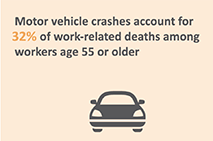MOTOR VEHICLE SAFETY AT WORK
Older Drivers at Work

Older workers (those ages 55 and older) bring extensive skills, knowledge, and experience built over the course of a lifespan. However, age-related physical and mental changes may affect older workers’ driving. While such changes are normal, they also put older drivers at a greater risk of dying if they are in a motor vehicle crash. Employers and workers share the responsibility for keeping older drivers safe at work.
What do we know about older drivers in the workplace?
Key Facts and Stats

- By year 2020:
- 25% of workers will be 55 years or older1
- 30% of Americans will be 55 years or older2
- 40 million licensed drivers will be 65 years or older3
- Research shows that older drivers are more likely than their younger counterparts to adopt safe behaviors such as wearing a seat belt and complying with speed limits. However, those age 55 and older have twice the risk of dying in a work-related crash than younger workers do.4 It is normal for physical and mental abilities to decline with age – putting older workers at greater risk of serious injury if they are involved in a motor vehicle crash.
- Motor vehicle crashes account for 32% of all work-related deaths among workers age 55 or older.5
How can you prevent crashes among older drivers at work?
Employers
Employers: Use the following recommendations to develop safety and health programs that consider older drivers’ needs.
- Consider whether the work can be done without driving. Reducing the amount of driving workers do is the most effective way to prevent motor vehicle crashes.
- Set policies that allow drivers to consult with their supervisors to adjust driving hours if they have trouble seeing at night, and to stop driving if they are too tired or the weather is bad.
- Provide “refresher” driving training that includes topics such as safe-driving strategies, changes in road rules, regulations on distracted driving, and new vehicle safety features.
- Restrict driving based on assessment of actual driving ability, rather than general health status or an arbitrary age limit.
- Give workers general information about the possible effects of prescription and over-the-counter medications on their driving.
Resources for employers:
NIOSH Center for Productive Aging and Work
Learn how to promote the safety of workers of all ages and their lifelong well-being.
CDC Older Adult Drivers
Understand how the risk of being injured or killed in a motor vehicle crash increases with age and learn about prevention strategies.
Roadwise RX
Encourage workers to use this resource from the AAA Foundation for Traffic Safety to learn how medications can affect their driving.
For a full list of recommendations and resources, download the Older Drivers in the Workplace fact sheet.
Workers
Workers: Take the following actions to stay safe while driving for work.
- Talk with your doctor or pharmacist about potential effects of your medications on safe driving.
- Get a thorough eye exam at least every 1-2 years, as your vision may change with age.
- Maintain good health by engaging in regular physical activity, eating a healthy diet, getting enough sleep, and complying with all health exams and screenings.
- Use a driving self-assessment tool to evaluate your driving.*
- Talk with your supervisor if you are having difficulty with driving, as you may need to change your driving habits.
Resources for workers:
*Roadwise Review Online
Take the AAA Roadwise Review, an interactive self-assessment tool to check your physical strength and flexibility, clarity of vision, and skill in processing what you see while driving.
National Highway Traffic Safety Administration (NHTSA)
Discover advice on how to talk with older drivers about safe driving.
My Car Does What
Learn about your vehicle’s advanced safety features.
For a full list of recommendations and resources, download the Older Drivers in the Workplace fact sheet.
Sources
1 Tossi, M. (2012) Employment outlook: 2010-2020. Labor force projections to 2020: a more slowly growing workforce. Monthly Labor Review, January 2013, 43-64.
2U.S. Census Bureau, Population Division (2014) Table 9. Projections of the Population by Sex and Age for the United States: 2015 to 2060 (NP2014-T9).
3Dellinger AM, Langlois JA, Li G. Fatal crashes among older drivers: decomposition of rates into contributing factors. Am J Epidemiol 2002;155(3):234–41.
4Based on 2011-2013 data from the Bureau of Labor Statistics Census of Fatal Occupational Injuries query system and 2011-2013 Employed Labor Force (ELF) population data.
52011-2013 data from the Bureau of Labor Statistics Census of Fatal Occupational Injuries query system.
- Page last reviewed: August 14, 2017
- Page last updated: August 14, 2017
- Content source:
- National Institute for Occupational Safety and Health Division of Safety Research


 ShareCompartir
ShareCompartir

